
Two teens run over a little green man. When the authorities refuse to believe them, they take on the alien invasion by themselves. AIP’s comedy from 1957 has a clever premise, but is marred by a messy script. 5/10

Invasion of the Saucer Men. 1957, USA. Directed by Edward Cahn. Written by Al Martin & Robert Gurney, Jr. Based on story by Paul W. Fairman. Starring: Steven Terrell, Gloria Castillo, Frank Gorshin, Lyn Osborn, Raymond Hatton. Produced by Robert Gurney, Jr. & James Nicholson. IMDb: 5.3/10. Letterboxd: 2.8/5. Rotten Tomatoes: 4.8/10. Metacritic: N/A.
It’s a typically quiet Saturday night in Hicksville, USA. The teens drive out to lover’s lane in the woods on farmer Larkin’s (Raymond Hatton) land and get his bull drunk. The police are mostly concerned with drunk drivers — when they don’t take prank calls from drunk teenagers claiming to have seen flying saucers. However, this time, teen lovers Johnny and Joan (Steven Terrell & Gloria Castillo) don’t imagine or make up little green men — they run one over with their car. Another person who sees the UFO is Joe Gruen (Frank Gorshin), who is in town with his partner Artie (Lyn Osborn), looking for easy money. When Johnny and Joan leave on foot to contact the police, Joe discovers the body of the alien stuck under the two lovers’ car, and calls up Artie, who’s asleep at the hotel, and tries to convince him they have a real, honest-to-god dead alien on their hands. Unfortunately, when Joe goes back to recover the little green man, he is attacked by other aliens injecting him with some sort of poison from their needle-like claws. Once he is dead, the aliens recover the body of their partner and ding up Johnny’s car, so that when the police do arrive, it looks as if Johnny has run over Joe. Not only will the police believe the danger of the aliens, but now Johnny is also accused of manslaughter.
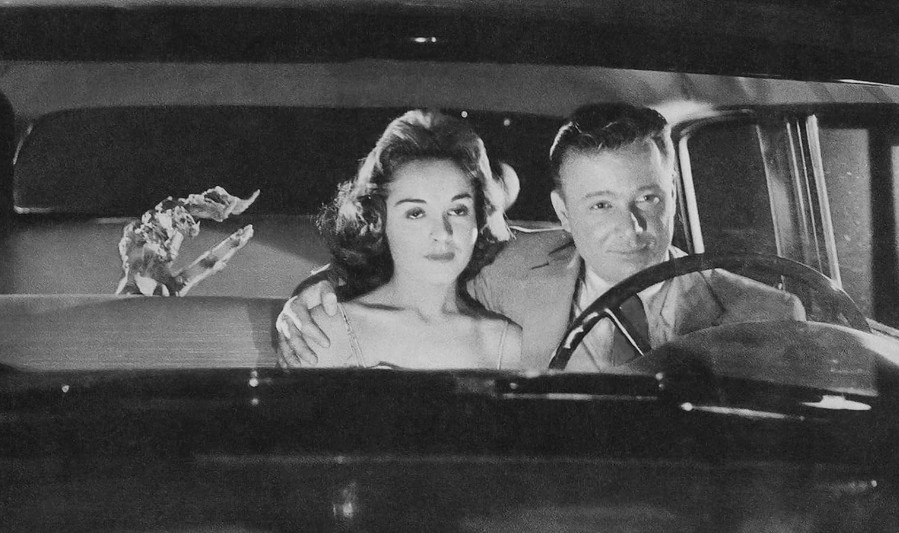
So begins American International Pictures’ 1957 science fiction comedy/spoof Invasion of the Saucer Men. It was released as the bottom bill alongside AIP’s iconic I Was a Teenage Werewolf (review), and is considered a minor cult classic today. The movie was produced by Robert Gurney, Jr. and AIP exec James Nicholson, and directed by low-budget journeyman Edward Cahn. The enormous bulbous heads of the little green men may well have inspired Tim Burton’s Mars Attacks! (1996). And for the rest of the plot description, remember to hold your tongue firmly in cheek.
While Johnny and Joe try to prove their innocense, the military catches wind of the saucer landing, and pulls out all the stops in order to catch the UFO, while keeping the public (and the police) ignorant about the alien threat. Under the command of Col. Ambrose (Sam Buffington), the USAF secure a perimeter around the saucer. When trying to blowtorch their way into the ship, it blows up. Unaware that the crew of the UFO is milling about in the woods, the clueless Ambrose and his team believe they have blown up the aliens, saved the day (night), and pat themselves on the back.

Meanwhile, Johnny and Joan escape police custody and visit Joe’s partner Artie at his hotel, convincing him that his friend has actually been killed by little green men. Finally, Artie takes the alien matter seriously and agrees to come out to the woods and have a look-see. When they arrive at the spot of the accident, they are attacked by aliens, who are invulnerable to bullets. However, the trio realise that they are hurt by the car’s spotlight. Unfortunately, the car battery goes dead and Artie is attacked, incapacitated and kidnapped by the aliens. Realising that the grown-ups will never take them seriously, Johnny and Joe go back to their friends at lovers lane, and convince them to hunt down the aliens with their cars and surround them with their headlights. Said and done; and when the green men are caught in the ring of lights, they explode in a puff of smoke, leaving no trace. In their place, they find a drunk Artie who can’t remember a thing of what has happenened. It turns out that the aliens inject their victims with pure alcohol, and the only reason Joe died was because he was already drunk. The police autopsy has confirmed that Joe died of heart failure do to alcohol poisoning, and the two kids are cleared of all criminal charges, and get married on the spot. The end.
Background & Analysis

Invasion of the Saucer Men got its start as so many AIP movies: with a title dreamed up by studio executive James Nicholson, as a bottom bill to go with I Was a Teenage Werewolf (1957, review). But in this case, AIP actually based its film on a pre-existing story. This was unusual, as AIP generally couldn’t afford to aqcuire the rights to novels or short stories. This time, however, AIP bought the rights to a short story from superfan and publisher Forrest Ackerman’s company. The story in question was Paul Fairman’s The Cosmic Frame, previously published in Amazing Stories in 1955, a magazine that Fairman edited.

Paul Fairman was a prolific writer in several genres, including detective thrillers, fantasy, horror and science fiction. We have encountered him on Scifist before, as his story Deadly City formed the basis of the low-budget picture Target Earth (1954, review). The “frame” part of The Cosmic Frame isn’t to be understood as a frame for a painting, but rather as in “framing someone for something”. The short story isn’t in and of itself comedic, like the film, but it is permeated by a sort of light-hearted and ironic cynicism that was popular among SF writers in the 40’s and 50’s. Like the film, the story stretches over the course of one night, but it is much more contained. It follows our teenage “heroes” Johnny and Joan who accidentally run over an alien. When they leave to fetch the police, the alien’s buddies retrieve the corpse and substitute its body with a farmer they kill. They dent Johnny’s car so it will look like he ran over the farmer. Naturally, when Johnny and Joan arrive with the police, they refuse to believe the kids’ fantastic story about little green men. In the end of the story, Johnny and Joan express irritation over the fact that adults never take teenagers seriously.

Screenwriter Al Martin has later said that the humorous elements of the film were present already in the script. However, this view is not held by AIP’s monster maker Paul Blaisdell. In an interview in Randy Palmer’s biography Paul Blaisdell, Monster Maker, Blaisdell states that James Nicholson came to him with a pitch for a serious horror/SF film inhabited by aliens that resembled the ones in the old pulp fiction stories of yesteryear: small green men with giant, bulbous heads. According to Blaisdell, everyone at AIP were excited about the movie, and thought Nicholson had come up with a genious idea. Blaisdell offered to make a small army of aliens invading Earth, but Nicholson had to remind him that the film’s budget was $70,000. Blaisdell dialed down the number to four aliens, plus a couple of “hero props”, an animated head and an animated hand, for close-ups.

AIP at the time had a roster of producers who basically operated their own, almost independent, units, and the films were often produced through their own small companies, rather than directly through AIP, which meant AIP didn’t have to employ all the people working for them. Roger Corman, Bert I. Gordon, Herman Cohen and Alex Gordon were among AIP’s household producers. Invasion of the Saucer Men brought in a new name, Robert Gurney, Jr. He was entrusted to borrow director Edward Cahn, an old-time Hollywood workhorse, who usually worked with Alex Gordon. This time, however, Nicholson was so pumped-up about the film that he signed on as co-producer, which he usually didn’t do (and according to Herman Cohen, he didn’t know very much about movie production). Blaisdell says that over the course of filming, the movie naturally evolved into a comedy.
The movie contains the basic elements of Fairman’s story. But it adds the whole subplot of the two con-men Joe And Art, and substitutes the farmer who is run over with Joe. The farmer instead became a comedy relief, who runs after teens who use his land as a make-out area with a shotgun. Screenwriter Al Martin also added a lengthy subplot involving Farmer Larkin’s prize bull, whom the teenagers do their best to get drunk on beer, and who, in a surprisingly gory scene, attacks one of the little green men. Then there’s the whole business with a hand that detaches from the dead alien and starts wreaking havoc, Addams Family-style. With the absurdity already contained in Fairman’s story, combined with these new ludicrous elements and Blaisdell’s ridiculous aliens, Blaisdell says that the whole team gradually felt during filming that the film was slipping into comedy, and decided to roll with it, playing it for laughs. In post-production Gurney also added a narration by Lyn Osborn (Artie), which set the comedic tone from the beginning. Ronald Stein added to this a cartoonishly bombastic score, further enhancing the comedy aspect.
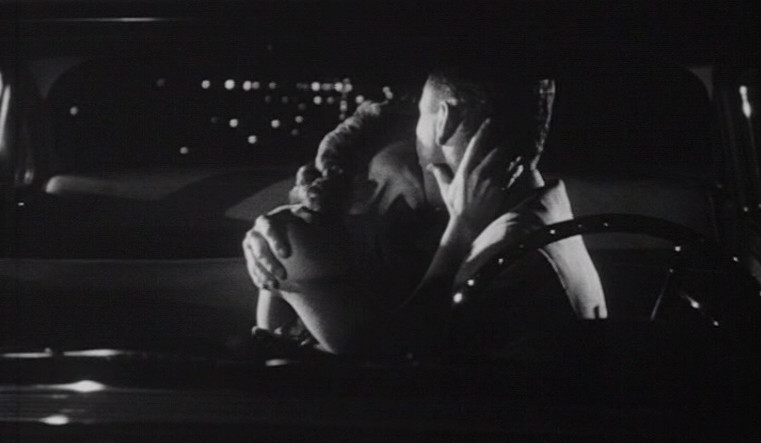
Invasion of the Saucer Men was produced after AIP hade made Herman Cohen’s I Was a Teenage Werewolf, which garnered much attention because of its title even before it had been released. AIP, which had made both SF/horror films and teenage delinquency films before, but separately, now threw all their gears into combining their two cashcow genres. The teen revolution of the 50’s had been cemented in Hollywood with the James Dean picture Rebel Without a Cause (1955), and movies about teens listening to rock ‘n roll, drinking, running away from home, joining biker gangs, making out in cars and getting put in juvenile correction facilities were now cropping up everywhere, despite warnings from a congressional committe on juvenile delinquency to not spur on the moral decay of the teen generation. Like in I Was a Teenage Werewolf, AIP inhabited Invasion of the Saucer Men with young no-name actors with a string of teenage movies behind them. Steven Terrell had been in Runaway Daughters (1956) and Dragstrip Girl (1957), and this was his first lead, and Gloria Castillo had also appeared in Runaway Daughters. The grown-up leads of Joe and Art were cast with reliable character actors Frank Gorshin (who also had substantial teensploitation resume) and Lyn Osborn. The acting in the film is adequate, at least. Whether or not you enjoy Lyn Osborn’s rubber-face antics is, I suppose, a matter of taste. There are many who think Osborn is the best part of the film, although I am not quite sold myself. Terrell, Gorshin and Castillo all do what is required of them in their respective roles. Raymond Hatton as Farmer Larkin has the thankless job of performing a tired cliché on two legs. Sam Buffington and Douglas Henderson as the two top air force types have good rapport.

As opposed to the majority of AIP’s films, Invasion of the Saucer Men was almost entirely studio-bound. Bob Burns, who worked as Blaisdell’s assistant, figures that 98 percent of the movie was filmed on an unusually large sound stage, which incorporated not only all the interior sets, but also most of the exterior sets. Generally, AIP utilised location shooting as much as possible, as this saved money both on studio rent and set building, and provided realistic settings free of charge. However, shooting a film which takes place entirely at night on location is another matter. Night shooting is expensive and day-for-night filming is tricky if you want to make it look good. But in a studio, it doesn’t matter whether it is night or day, as you control all the elements.

Of all AIP’s go-to directors, Eddie Cahn was probably the least exciting. Without doubt the most experienced, and perhaps technically the most competent, but always more interested in simply getting a scene in the can than doing anything original with it. Cahn’s direction is pedestrian, but nevertheless, Invasion of the Saucer Men is probably the best of his films we’ve reviewed here on Scifist. It’s in a whole different class than the dreary Voodoo Woman (1957, review), and at least as good as Creature With the Atom Brain (1954, review), which suffered more, perhaps, from a weak script that weak direction. The most exciting sequences in the film are those involving the creature effects — and those sequences were directed by Paul Blaisdell, uncredited. The film is also helped by cinematographer Frederick West’s suggestively dark lighting, creating an atmopshere of suspense and mystery. Some might even call the film murky.
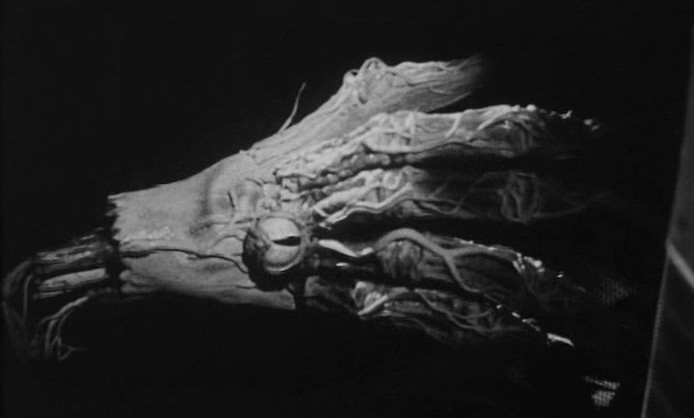
Invasion of the Saucer Men is one of Blaisdell’s most impressive projects, just in terms of numbers. Usually, Blaisdell was tasked with creating one monster suit and perhaps some small gadget. In this film, he created four monster suits, one animated monster hero head, and two animated monster hands. One of the hands had retractable needle stingers that needed to visibly eject a liquid (the alcohol), and was used for close-ups of fight scenes and for illustrating the menace of the aliens. The other hand was the one that broke away from the body of the dead alien, and then went on in the film to have a complete story arc of its own. This hand was built on top of a glove, and Blaisdell himself animated it with his own hand during the entire film, wearing a black costume against black backgrounds or hiding on the floor of the car in which much of the hand action takes place. This is really quite impressive puppetry stuff going on, and illustrates the level of originality, sophistication and just sheer dedication Blaisdell brought to the AIP films. The kind of effects that today requires a small army of designers, manufacturers, make-up people, green screen operators, digital animators and creature actors, Paul Blaisdell did by himself, often on a budget no bigger than a couple of hundred dollars.

Not all by himself, though. The person often forgotten in this equation is his wife Jackie, who worked as an assistant on all of his assignments, helping to create, manufacture and operate many of his creature effects. Then there was also Bob Burns, who is best known today as a movie memorabilia collector and amateur film historian, but who also worked as Blaisdell’s assistant on many films.
For the alien costumes, James Nicholson had ordered suits for small actors — little people — with enormous, bulbous heads. As he needed four, fast and cheap, Paul and Jackie abandoned their usual approach of using latex on wire frames, and instead decided to make fibreglass heads using molds, which were then embellished with latex details, like the veins running along the the aliens’ heads. These were not animated, and so were used primarily in wide and middle shots. Beacuse of all the work required, the Blaisdells didn’t create entire costumes for all the aliens, only the hands and heads, and outsourced the task of making clothing for the little green men to the wardrobe department. Anyone looking closely will see that the aliens are wearing ballet shoes. There was a snag in the production when Blaisdell presented the heads to producers Gurney and Nicholson, and Gurney though the heads were too big. However, Paul and Jackie were able to “shrink them down” in time for filming. The hero head had moving eyes, a mouth and a latex face that Blaisdell could ever so slightly animate in order to vary facial expressions. The back of the head was open, so that Paul could animate the face from behind.

The eyes were made out of followed-out styrofoam balls, so that they would break easily in the bull fight scene, where the bull gouges the alien’s eye out with its horn. Using an ear syringe, Blaisdell had blood spurting out of the eye — actually chocolate syrup. The attack scenes in the film are surprisingly gory — however Blaisdell said the stuff they filmed was even more gory, but Cahn decided to turn the ick-factor down, afraid they would get into trouble for too much blood and violence. As stated, the monster scenes directed by Blaisdell are the best of the film, but credit must also be given to editor Charles Gross, Jr., who expertly mixes inserts, wide shots and close-ups into a hectic flurry of action in the fight scenes. No bulls were harmed – Blaisdell and Burns used a prop head. However, one scene was also filmed on a pasture with the star bull trying to shake off an alien dummy which has been attached to its head. Bob Burns was also on hand for all of the filming, helping Paul with the effects shots. Both he and Paul also worked as stand-ins for several of the actors. In one crucial scene where Art is attacked by the aliens, the actor, Lyn Osborn, refused to go anywhere near Blaisdell’s needle glove. In order to prove that it was harmless, Paul stuck the prop into the neck of Burns, illustrating that the needles simply retreated into the glove without doing any damage. But Osborn wouldn’t have it, he just looked at Burns and said: “Great, you do it then!” So in the dramatic scene where the aliens sting Art in his neck and face, that is actually Bob Burns on screen.

The aliens were played by four actors of small stature, most of which had few other movie appearances — with the exception of Angelo Rossitto, who was a movie veteran. As he was shortest, Blaisdell thought it would be fun to make him the leader. For more demanding scenes, Blaisdell and Burns donned the fibreglass heads. One scene in particular was harrowing for Blaisdell. Towards the end of the film, Art shoots at the aliens with no effect. Blaisdell decided to put squibs on the head of the alien he was portraying to illustrate the impact. However, he didn’t count on the small explosions to reverberate inside the fibreglass helmet, and he was deaf for the rest of the day.
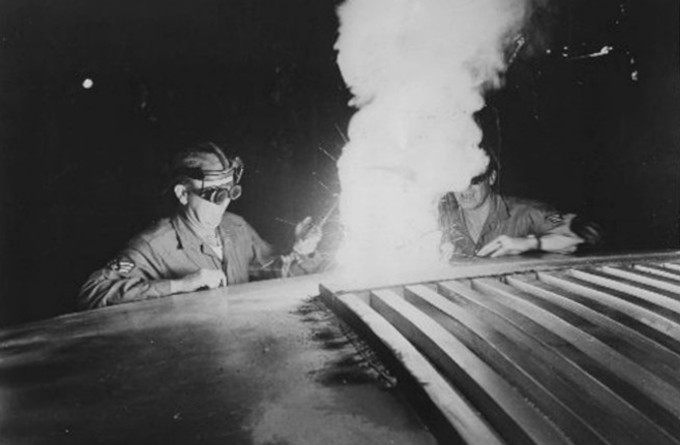
The script for Invasion of the Saucer Men is all over the place. This is not surprising, as Al Martin was the originator of the script for The Mad Doctor of Market Street (1942), which I in my review called “an inane and disjointed script”. There are some nice ideas here. The central premise of the teens running over an alien, only to find that no-one believes them is a fun, cynical theme, that might have worked great as a 20-minute TV episode. But it’s not enough to sustain an entire movie. Martin thus adds bits and bobs to pad out the running time, some better than others. The clueless military men is another fun theme, but one that could have been developed further, or even stood as the central premise of the movie. As it is, it doesn’t have any bearing on the main plot – the teens don’t even ever see the flying saucer. The idea of the aliens poisoning their victims with alcohol is another fun idea, but, again, the idea isn’t developed into anything substantial, but rather comes in almost as an afterthought towards the end of the film. Martin isn’t able to do anything meaningful with the characters of Joe and Art. Terrell and Osborn have a nice buddy rapport, which is cut short with the death of Joe – a death, by the way, that Art takes completely in his stride, like someone told him that his bus is three minutes late. After this Art really has no function in the film, and we don’t really care one way or the other when he is attacked and abducted. I suppose that the attacks in the movie were so brutal and graphic, that the filmmakers didn’t feel comfortable with having the leading lady abducted, as per usual. However, the film trots along at a decent pace, and while many of the jokes fall flat, I like its overall cheeky attitude towards authority and adults in general – be it that it is sometimes written the audience on the nose.

Invasion of the Saucer Men has become something of a minor cult classic, mainly because of its silly but memorable aliens. The aliens in Tim Burton’s big-budget satire Mars Attacks! (1996) are loving homages to Paul Blaisdell’s design. It’s a creaky and uneven movie as far as scripting goes, and most of the stated jokes fall flat. However, it is built on a fun central premise, and some of the subplot themes are rather clever, even if Martin and Gurney aren’t able to develop them or incorporate them in a satisfactory manner into the main plot. The takeaway of the film are the energetic action scenes and Blaisdell’s no-budget special effects, skilfully framed, blocked and edited as to overcome the film’s meager budget and lightning-fast shooting schedule of seven days. Director Edward Cahn, cinematographer Frederick West and art director Don Ament create sone genuinely moody and tense moments by shrouding much of the forest setting in perpetual darkness, which actually lends the silly monsters an air of menace. Ronald Stein’s over the top music nicely heightens the movie’s attempts at straddling the space between comedy and horror. It’s not a good movie, but if you’re in the right mood, it’s an entertaining one.
Release & Reception

Invasion of the Saucer Men was released as the bottom of a double bill with AIP’s I Was a Teenage Frankenstein (review), which became a phenomenon. The double bill raked in a profit of $2 million, AIP’s biggest success to date. The film received little interest from newspapers, and even in trade papers, reviews were scarce. Variety wrote: “Film suffers from poor use of attempted comedy, and is further handicapped by a haphazard sort of yarn which makes film’s 69-minutes’ running time seem much more”. Harrison’s Reports was slightly more positive, calling it “an ordinary program melodrama”, and noted that it had its “horrific moments” and “satisfactory” photography. British Monthly Film Bulletin was a little more positive: “The moments of burlesque of horror melodrama traditions, whether intentional or not, are at least curious. The trickeries are quite convincingly staged, but the film is juvenile in approach and treatment”. In the UK, the film was released as Invasion of the Hell Creatures.

This movie has a 5.3/10 audience rating on IMDb, based on over 2,000 votes, and a 2.8/5 rating on Letterboxd. Rotten Tomatoes gives a 4.8/10 critic consensus. TV Guide calls it “intentionally funny”. AllMovie gives it 2.5/5 stars, with Hans J. Wollstein writing: “Invasion of the Saucer Men simply isn’t funny but is clearly meant to be”. In his book The Encyclopedia of Science Fiction Movies Phil Hardy calls it a “dismal offering”, and writes that the tackling of the film’s themes are “half-hearted”. Most current-day reviewers praise Paul Blaisdell’s work, but find the film, as Richard Scheib puts at Moria in his 2/5 star review, “dreary”, or Kevin Lyons at EOFFTV, “virtually meritless”. However, while no-one seems to feel there is much class to the proceedings, there are those who, like me, enjoy it nevertheless. In his 2/4 star review, Derek Winnert says that it provides “a lot of amusing, campy fun”, and Kris Davies at Quota Quickie opines that “the film holds together, remarkably well despite everything. Its a fun film and a decent watch.” Dave Sindelar at Fantastic Movie Musings and Ramblings writes: “it’s directed with a certain energy, features some truly memorable aliens courtesy of Paul Blaisdell, juggles its three storylines with ease (the two opportunists, the teenagers, the military), and in its own way, it may be THE quintessential aliens vs. teenagers movie.”
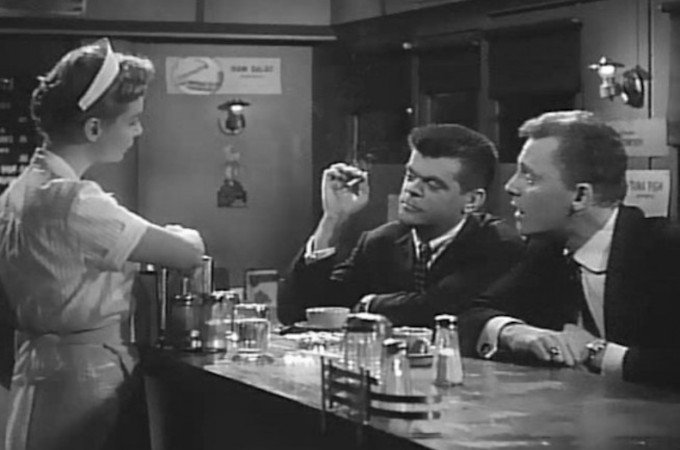
Mars Attacks! isn’t the only film that pays homage to Invasion of the Saucer Men. In fact, in 1965 Schlockmeister Larry Buchanan remade the movie for AIP as a TV film called The Eye Creatures. Dave Sindelar writes: “anyone who has seen [Invasion of the Saucer Men] in tandem with Larry Buchanan’s awful remake The Eye Creatures can at least appreciate the world of difference simple competence can make in the production of movies like this.”
Cast & Crew

There is little information available on the life and career of producer Robert Gurney, Jr. Invasion of the Saucer Men was his first production credit, and he co-wrote and produced three more films for AIP in 1957 and 1958, including the infamous Terror from the Year 5000 (1958, review). In 1964 he wrote, produced and directed the comedy The Parisienne and the Prudes, which was supposedly a satire on McCarthyism set at a nudist colony. It only ever played at Cannes.
Although not nearly as well-known to a mainstream audience as Ed Wood or Roger Corman, Edward L. Cahn is synonymous with the 50’s subgenre of so-bad-they’re-good Z-movies. Cahn began his career in the films as early as 1917 as a production assistant, and soon graduated to editing at Universal. Eventually, he became one of the studio’s top editors, before switching to directing in the early thirties, “turning out cheap and cheerful crime melodramas and comedies”, according to an IMDb bio by I.S. Mowis. Pretty much flying below the radar at Universal and MGM, he struck out as a freelancer in 1945, with much work but little recognition, making B-movies and shorts for various companies.

However, after a dry spell in the early 50’s, Cahn was back with a vengeance, now with his eyes set on the minor studios that were producing B-movie quickies for a teenage audience, like Columbia, Allied Artists and not least AIP. Cahn was hired to make movies that called for little artistic flair, but a steady directorial hand by someone who agreed to work fast, cheap and didn’t care too much about the end result, as long as there was a comprehensible film in the can, which could be sold to indiscriminate teenagers on the power of the poster alone. Not quite as prolific as Corman, Cahn still churned out at half a dozen films, sometimes more, each year between 1955 and his death in 1963. He became a go-to guy for crime thrillers, westerns and horror movies, with a seeming knack for zombie films. But he also made more traditional teen or “rock and roll” movies, as well as girls-in-prison films. His science fiction films include Creature with the Atom Brain (1955, review), Voodoo Woman (1957), Invasion of the Sauce Men (1957), Curse of the Faceless Man (1958), It! The Terror from Beyond Space (1958) and Invisible Invaders (1959). Best known of these is probably It! The Terror from Beyond Space, on the merit of it being one of the many works to inspire Ridley Scott’s Alien (1979).
If screenwriter Al Martin struggles at finding the right tone for a 50’s teen movie, he can be forgiven, as the man was born in 1897, and began his movie career writing title cards for silent films. In short, one can say that Martin had a prolific but unspectacular career as a screenwriter.

At 28, Steven Terrell was a tad too old to be playing teenagers. In fact, he was four years older than Frank Gorshin, playing the adult in the movie. He soldiered on in B movies and TV between 1952 and 1965, when he dropped out of acting to devote himself to religion. He later founded a Christian theatre group. Gloria Castillo ping-ponged between leads in B-movies like Invasion of the Saucer Men (1957), Teenage Monster (1957, review) and Reforms School Girl (1957), TV and a few bit-parts in bigger films. She dropped out of acting in 1967 and had some success with her and her husband’ women’s clothing company.

Frank Gorshin had a long career as an actor, stand-up comedian and impersonator. In movies, he was generally cast as either a tough guy (due to his resemblance to James Cagney) or in comedic roles, mostly supporting or bit-parts. He appeared regularly on TV and is best known for playing the Riddler in the Batman TV series (1966-1967) for which he was nominated for an Emmy. In 1982 he also had a recurring role on the TV series The Edge of Night. He voiced Dr. Strange in the animated TV series The Batman in 2005. He passed away the same year. He also appeared in The Meteor Man (1993) and Twelve Monkeys (1995).
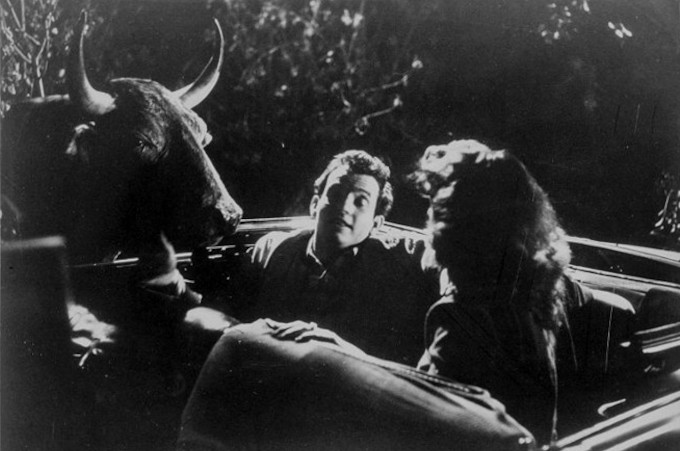
Lyn Osborn joined the navy in 1943, but the war ended before he was called to battle. After doing his term with Uncle Sam, Osborn worked several jobs before hitchhiking to California, where he eventually enrolled in the Pasadena Playhouse on the G.I. Bill. He spent three years there, and around the time he graduated, he got his big break as he was cast as the co-lead of Cadet Happy on the TV show Space Patrol. Over the course of five years (1950-1955), over 1200 daily episodes were made, as well as one longer weekly, Saturday morning episode. The same cast and crew also produced a radio show. The hugely popular series was intended for children, but also retained a sizeable adult audience. Unsurprisingly, Lyn Osborn was in demand for science fiction movies after the show ended in 1955, and he appeared in such films as Invasion of the Saucer Men (1957), The Amazing Colossal Man (1957, review) and The Cosmic Man. Tragically, Osborn’s life was cut short, as he passed away during brain surgery due to a brain tumor in 1958.

The rest of the cast is made up of reliable supporting and bit part-actors. Raymond Hatton, playing Farmer Larkin, had a notable career in the silent era, but was relegated to bit-parts with the coming of sound. He appeared in close to 500 movies. Russ Bender, playing a doctor, appeared in small roles in a number of science fiction movies, beginning with an uncredites role as Dr. Carmichael in The War of the Worlds (1953, review). In a tongue-in-cheek nod, he played a character called Dr. Carmichael in The War of the Colossal Beast (1958). He often appeared as military men, doctors and other authority figures, in films like It Conquered the World (1956, review), Invasion of the Saucer Men (1957), The Amazing Colossal Man (1957), Panic in Year Zero! (1962), The Satan Bug (1965), Space Probe Taurus (1965) and The Navy vs. the Night Monsters (1966).

In a minor role we see AIP staple Ed Nelson, who played the crab in Attack of the Crab Monsters (1957, review). Nelson had some TV, radio and stage experience before arriving in Hollywood in the mid-50’s, and promptly became one of the key members of Roger Corman’s stock company, doing a bit of everything and anything, often uncredited. After his stint with Corman, Nelson made himself a name as a TV actor, and hit mainstream fame as one of the leads in the soap opera Peyton Place (1964-1969). Along with Barbara Parkins, he was the only actor to appear in both the first and the last episode, and to be credited in every episode. Nelson also appeared in Invasion of the Saucer Men (1957), The Brain Eaters (1958), Teenage Caveman, Night of the Blood Beast (1958), Deadly Weapon (1989) and Jackie Chan’s Who Am I? (1998).

James Bridges found bigger success as a writer and director than as an actor. He wrote 16 episodes of The Alfred Hitchcock Hour, including “The Unlocked Window” (1965), wich received an Edgar Allan Poe Award, and “The Jar” (1962), which was nominated for an Emmy. He penned or co-penned around 15 films, including the sci-fi Colossus: The Forbin Project (1970), which was nominated for a Hugo Award. Bridges co-wrote and directed the Oscar-nominated comedy drama The Paper Chase (1973) and the critically acclaimed The China Syndrome (1979), starring Jane Fonda, Jack Lemmon and a young Michael Douglas, about a reporter investigating an apparent cover-up of safety hazards at a nuclear power plant. The screenplay was nominated for an Oscar, and both Fonda and Lemmon were given Oscar nods. The film was nominated for a Best Movie and Best Screenplay Golden Globe, and Bridges was nominated as Best Director. The movie was even up for a Golden Palm at the Cannes Film Festival. Converesely, Bridges also co-wrote and directed the rom-com Perfect (1985), which was nominated for three Razzies, including one for worst screenplay.

Angelo Rossitto had a long and awe-inspiring movie career spanning 60 years, from 1927 to 1987. He appeared in a dozen science fiction films, from playing an underwater creature in The Mysterious Island (1929, review), to appearing as the shorter half of the Master Blaster tag team in Mad Max Beyond Thunderdome (1985). Rossitto had roles in some of the most terrible SF films in movie history, including The Corpse Vanishes (1942, review), Mesa of Lost Women (1953, review), Brain of Blood (1971) and Dracula vs. Frankenstein (1971). He was also one of the Freaks in Tod Brownings legendary cult movie, appeared as a munchkin in The Wizard of Oz (1939), an Arena midget in Cecil B. Demille’s Samson and Delilah (1949) and was a voice actor for Ralph Bakshi’s The Lord of the Rings (1978). Interestingly enough, he also worked as a stunt double for Shirley Temple. The small roles he was able to secure in films were not enough to sustain him, and his steady income came from running a news stand in Hollywood.

Monster maker Paul Blaisdell studied art in Boston, and upon graduation married his wife Jackie and moved to California, where he ended up working for Douglas Aircraft. On the side, he drew illustrations for science fiction magazines. In the early 50’s editor and superfan Forrest J. Ackerman became Blaisdell’s agent, and it was through him that producer/director Roger Corman ended up commissioning the monster and the spaceship for The Beast With a Million Eyes (1955, review) from Blaisdell. Impressed with Blaisdell’s work — or perhaps rather his ability and willingness to do elaborate work for next to no renumeration — AIP executives ended up commissioning almost all their monster suits and models from Blaisdell in the late 50’s. Not only that, he often also designed space ships, set pieces and props for the movies, and, not least, acted as the monsters.

Blaisdell often made his costumes from materials like latex, foam rubber and wires. His monsters were generally rather cartoonish, with recognisable human-like features, such as two angry eyes, a nose, a perpetually snarling mouth, and almost always pointy ears. It didn’t matter whether they were tree stumps, giant crabs or cucumber-shaped monsters from outer space, they always seemed to have cartoonish human faces. He seemed to have a special love for conical forms, scales, spikes and creatures with leathery skin. While often ridiculed, they are likewise beloved for their unique wackiness.

Considering how many iconic monsters and aliens Blaisdell has created, it is amazing that he only worked in the movie business for about five years. After his design pitches for two AIP movies in the early 60’s were not picked up, he left the movie business. He worked briefly on a monster movie magazine alongside lifelong friend Bob Burns in the early 60’s, but after their printer burned down the printing house for the ensurance money, he resaddled and became a carpenter. He sadly died of cancer in 1983, only 55 years old, and didn’t get to experience the full popularity resurgence of his movies in the video era. It would be nice to write something here about his wife and collaborator Jacqueline “Jackie” Blaisdell, but unfortunately, information is scarce even in Randy Palmer’s biography. Jackie lived to 2006, but became extremely recluse after the death of her husband.
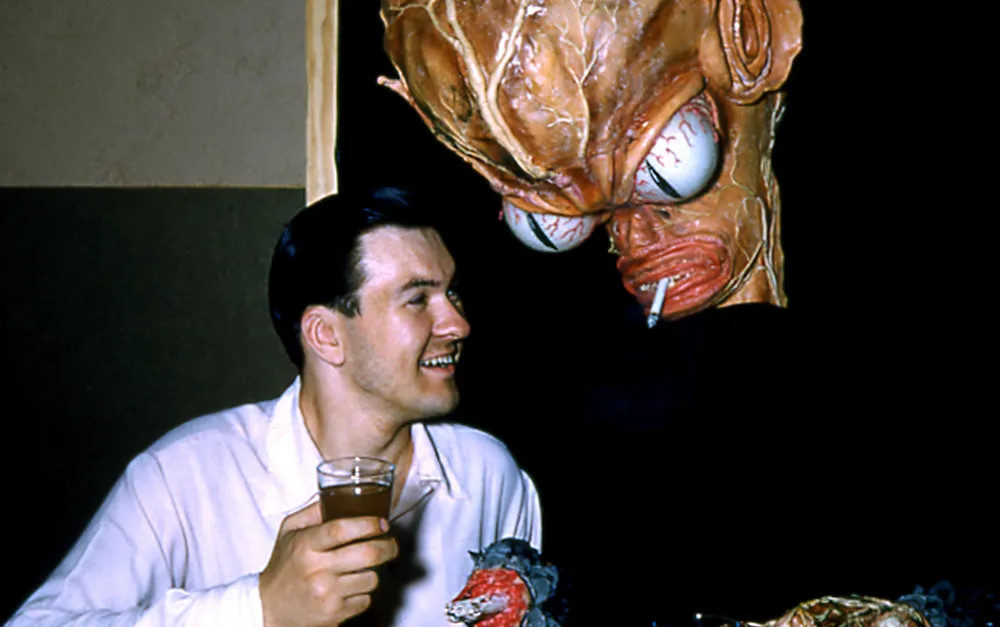
Although I have looked, I haven’t found an answer to what Bob Burns actually did for a living during his career. Burns wasn’t an artist, actor, writer or filmmaker. His career does list 37 acting credits between 1951 and 2015, both in bit-parts and as a suit actor, but these wouldn’t have been enough to sustain him on their own. What we do know is that Burns grew up in Hollywood and became enthralled with the magic of movie props and monster makeup from a young age, and was barely out of his teens when he started working as an assistant for Paul Blaisdell. Whether or not he got any money from this work is unclear. He’s got scattered credits for working on super-low-budget films in several capacities, from graphic designer to editor, to special effects technician, set decorator and makeup artist. What he is most famous for, however, is that he own’s the world’s largest collection of memorabilia from SF and horror films — in his bungalow in Hollywood — from the original King Kong torso armature to George Pal’s time machine, and the largest collection of props and memorabilia from Aliens. Burns is a legend in the field of creature makeup and special effects for his private museum, where many world-renown special effects creators have spent days and weeks figuring out the mechanics behind the trade. Known as an extremely generous and helpful man, Burns has readily parted his wisdom and know-how to hundreds of would-be filmmakers, researchers, archivists and historians. Burns, along with wife Kathy, were also lifelongs friends with Paul and Jackie Blaisdell.
Janne Wass
Invasion of the Saucer Men. 1957, USA. Directed by Edward Cahn. Written by Al Martin & Robert Gurney, Jr. Based on the short story The Cosmic Frame by Paul W. Fairman. Starring: Steven Terrell, Gloria Castillo, Frank Gorshin, Lyn Osborn, Raymond Hatton, Russ Bender, Douglas Henderson, Sam Buffington, Jason Johnson, Don Shelton, Angelo Rossitto, Ed Nelson, James Bridges, Paul Blaisdell, Bob Burns. Music: Ronald Stein. Cinematography: Frederick West. Editing: Charles Gross, Jr. Art direction. Don Ament. Makeup: Charlie Taylor. Sound recordist: Philip Mitchell. Special effects: Paul Blaisdell, Bob Burns, Howard Anderson, Alex Weldon. Produced by Robert Gurney, Jr. & James Nicholson for Malibu Productions & American International Pictures.

Leave a comment